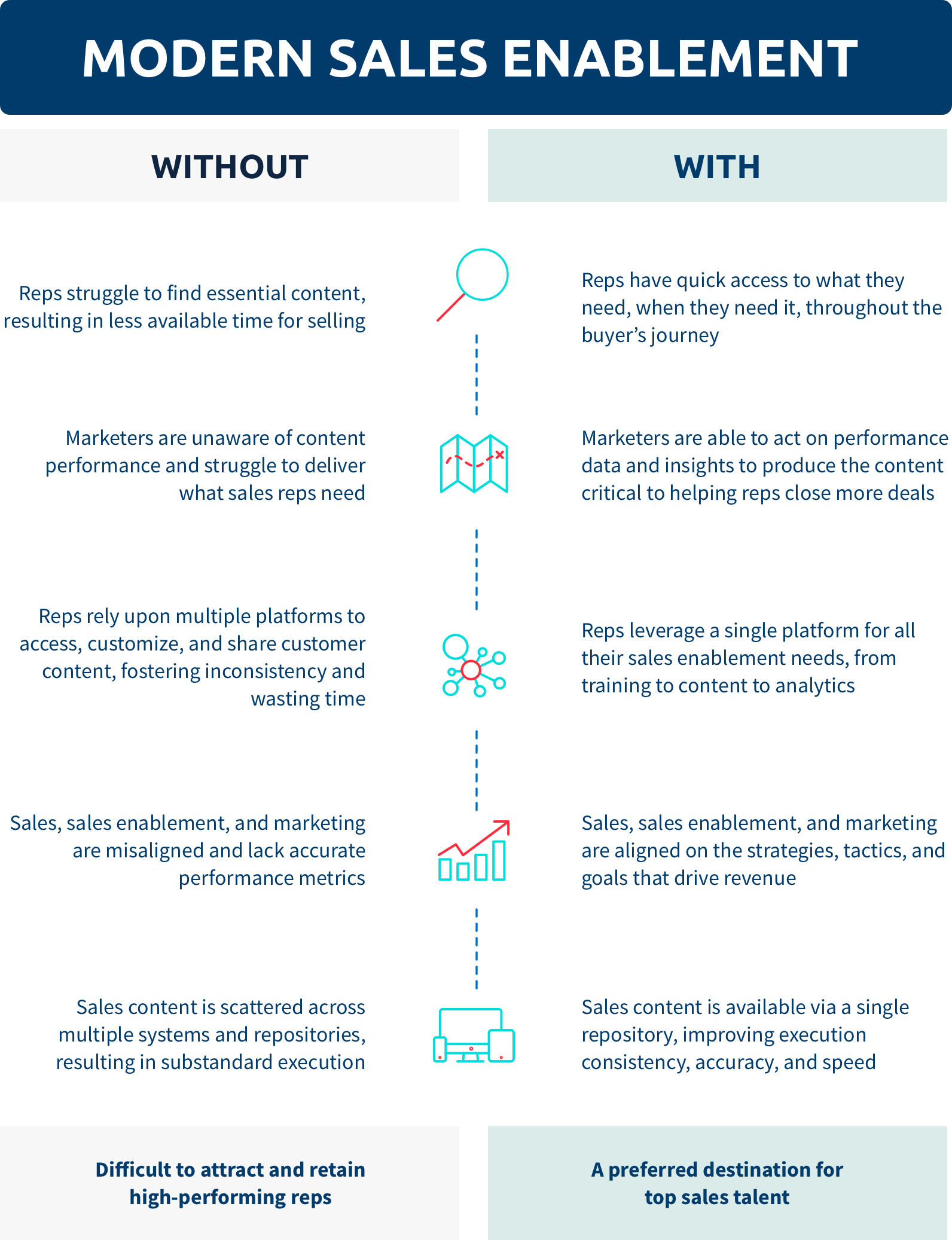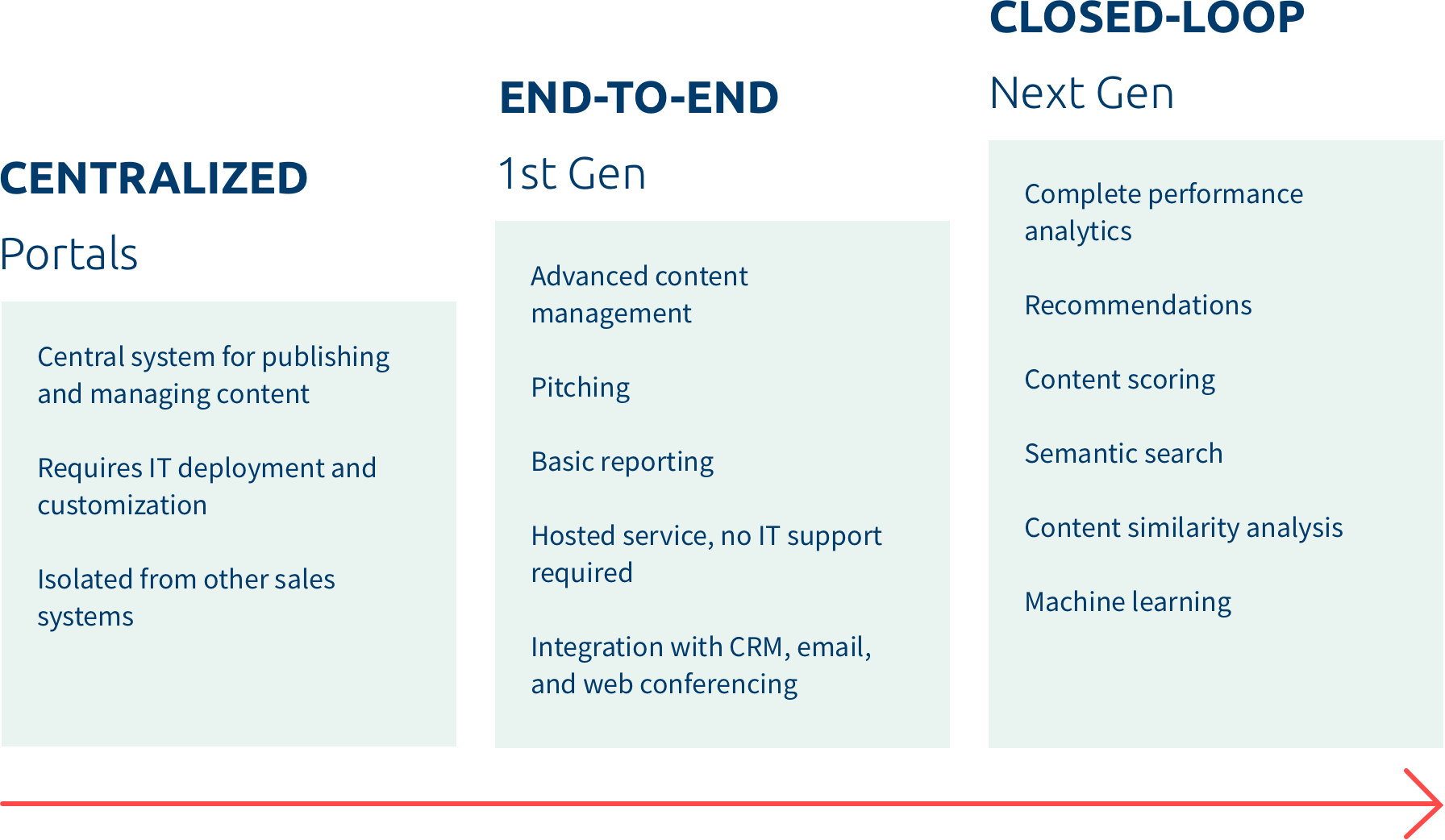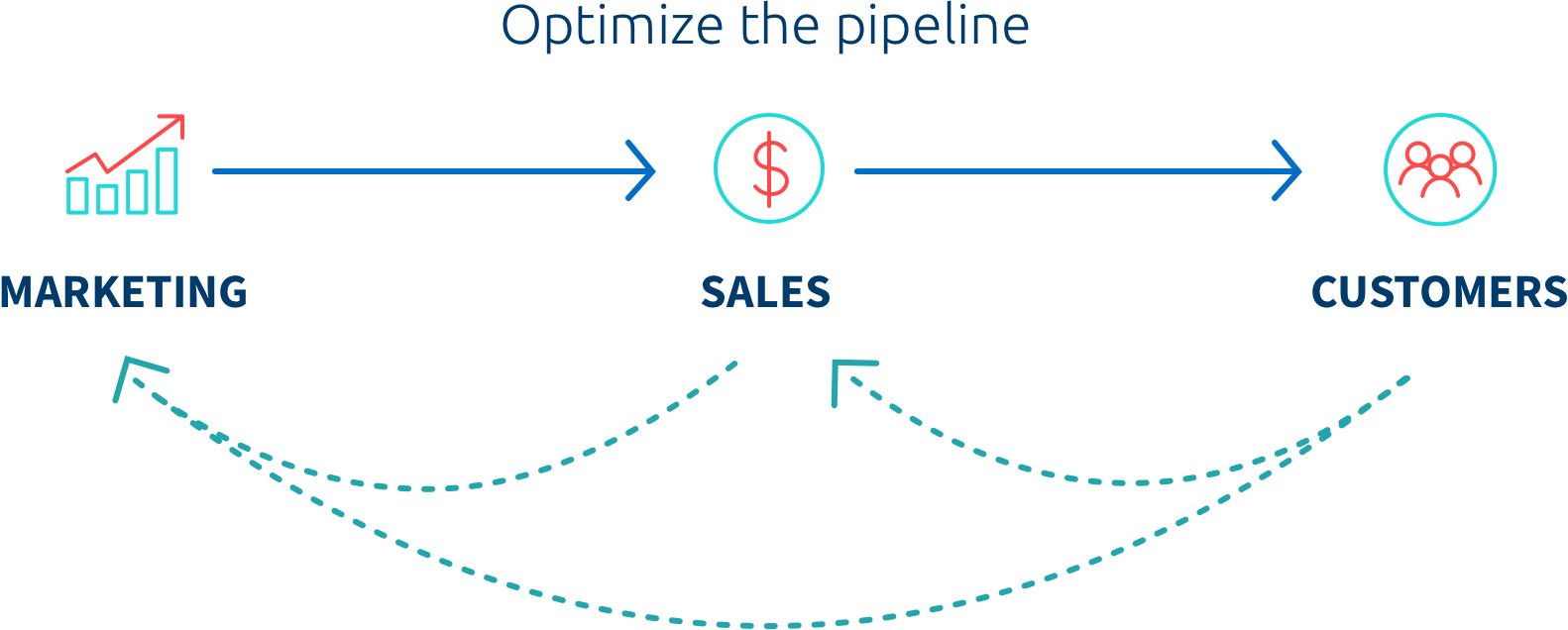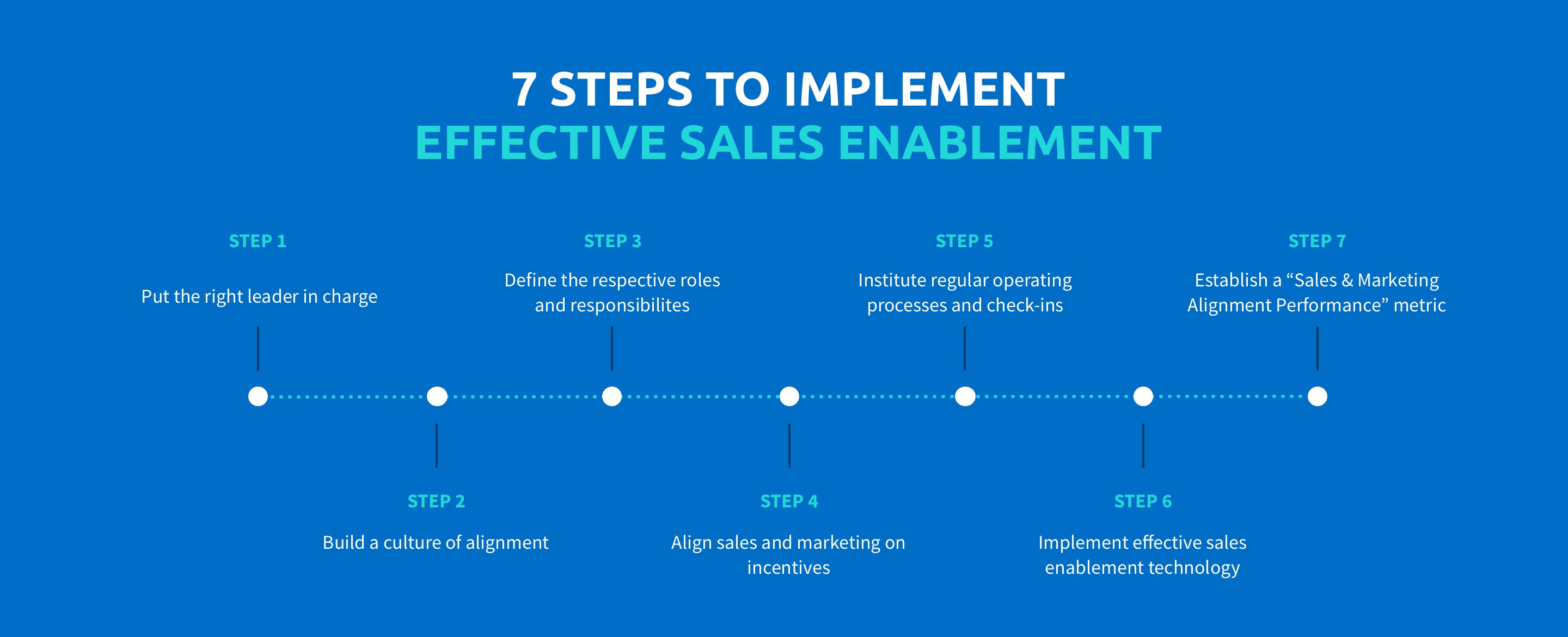Updated January 2022
Welcome to the industry’s most popular definitive guide on sales enablement. This guide provides a wealth of best practices, examples, reports, and online resources. Consider this your go-to resource as you design and deploy an effective sales enablement strategy for your business.
When it comes to sales enablement, here are the facts: 20 percent of reps are responsible for 80 percent of revenue. If you work in a go-to-market role, you might be wondering, “How can I help empower all of my reps, not just the top performers, with the skills and training they need to close deals?” This industry guide is your toolkit to understanding sales enablement, including best practices, testimonials, and effective strategies for your teams.
Let’s start by answering these six basic questions:
But this is just the beginning. Click through other chapters for even more sales enablement tools and guidance.
What Is Sales Enablement?
Sales enablement is the strategic, ongoing process of equipping sales teams with the content, guidance, and training they need to effectively engage buyers. Sales enablement analytics provide marketing and sales teams with data-driven insights to optimize their business and drive revenue.
Placing a focus on sales enablement makes sales teams more effective by…
- Connecting sellers to relevant content
- Providing flexible ways to present content
- Delivering real-time visibility into customer engagement
- Applying advanced analytics to optimize pitches
- Equipping sellers with training and guidance
- Measuring all of the above and mapping against bottom-line results
Let’s break this definition down further and step through three defining principles of sales enablement.
Principle 1: Commit to a Sales Enablement Process
Establishing a process for sales enablement provides the necessary framework to begin coherently organizing, finding, sharing, customizing, and analyzing content. This process requires input from multiple teams, clear expectations, and a plan to execute on sales enablement goals. But remember — it shouldn’t be a one-and-done, set-in-stone strategy. As an ongoing process, your sales enablement plan should allow enough flexibility to evolve or pivot when you need. This agility will help you keep up with buyers’ changing needs and stay ahead of the competition.
Principle 2: Know and Involve Your Sales Team
Think of the sales process as a funnel with four basic stages. The upper half, comprised of the “Awareness” and “Consideration” stages, is owned by marketing and is focused on generating interest in the company’s products and services. Marketing automation software has transformed that part of the sales cycle. This allows companies to reach out to a broad audience and nurture leads until they are ready to engage with the sales team.
The lower half is primarily owned by sales and is focused on closing deals and generating revenue. Sales enablement software is the new key player in transforming this part of the sales cycle. Sales enablement software equips sellers with the tools, skills, and assets they need to effectively engage with buyers and drive maximum revenue for the company.

Sales teams are the focus of sales enablement efforts. They are the primary reason businesses invest in sales enablement, and they are the essential stakeholders. Working alongside marketers, sales teams can dramatically improve the quality of their customer engagements as a result of sales enablement.
We focus on sales teams because they need every edge available. They move fast, think fast, and require access to content wherever business takes them. Keeping the sales team’s requirements top-of-mind throughout every aspect of content management, publishing, and engagement is essential to getting the most out of your sales enablement investments.
Principle 3: Engagement Equals Revenue
Sales enablement improves performance by helping reps consistently engage with prospects and customers throughout the buyer’s journey.
Every salesperson knows that engagement = opportunity. To win deals, sales content strategy and execution must be precise, data-driven, and in the format most useful to the target audience. There’s no time for prolonged sales collateral searches, presentation disconnects, dropped mails, or untrackable conversations.
Technology should be considered a springboard for this engagement. But without strong process, focus, and intention, the benefits of sales enablement technologies are inherently limited. Best practices are built upon this foundation.
By thinking strategically and applying best practices in the critical areas of content management, training, playbooks and sales operations, sales enablement can drive astounding results and transform sales effectiveness.
We’ve summarized some final thoughts on sales enablement in the videos below.



IN SHORT: Sales enablement helps reps do their jobs better by giving them the training and tools they need to close deals. To create a winning sales enablement strategy, be sure to prioritize processes, involve your sales teams, and increase content engagement.
What Are Analysts Saying About Sales Enablement?
Leading analyst firms have taken note of the growth of sales enablement. We’ve rounded up some key takeaways and definitions here.
For a directory of analysts covering sales enablement, please see our Sales Enablement Analyst Directory.
Sales Enablement Society
“Sales enablement ensures buyers are engaged at the right time and place, and with the right assets, by well-trained client-facing staff to provide a world-class experience along the customer’s journey, while utilizing the right sales and performance management technologies in addition to synergizing cross-organizational collaboration. Sales enablement optimizes the selling motion in order to increase pipeline, move opportunities forward, and win bigger deals more efficiently to drive profitable growth.”
Forrester
“Sales enablement is a strategic, ongoing process that equips all client-facing employees with the ability to consistently and systematically have a valuable conversation with the right set of customer stakeholders at each stage of the customer’s problem-solving life cycle to optimize the return on investment of the selling system.”
Gartner
“The activities, systems, processes, and information that support and promote knowledge-based sales interactions with client and prospects.”
The above definitions are more similar than different, reflecting the growing maturity of the sales enablement space. Foundational to all of these sales enablement definitions is ensuring that sales teams have the right content and knowledge to have effective conversations with customers.
Why Is Sales Enablement Important?
With heightened competition due to lower entry barriers and more empowered buyers, sales enablement saves sales and marketing teams valuable time by keeping them aligned and in tune with content performance.
Businesses today operate in a new reality: the way that buyers evaluate and make purchase decisions has changed. Modern buyers have become more independent, and traditional sales and marketing techniques no longer work to win and retain these customers. Today’s buyers have a strong preference to buy from sellers that can add value and help them with their purchase decision. In fact, 74 percent of buyers choose to move forward with the sales rep that’s the first to share value and insight.
To adapt to these new expectations, strong sales enablement is not just a nice to have — it’s a competitive necessity. Sales reps need to have the right content at the right time in order to keep buyers engaged.
As buyers have changed, so have sales reps’ requirements. The need for sales enablement first became apparent in the late 1990s, when sales conversation moved from physical to digital and content moved online. The “marketing closet” became a thing of the past as companies put their content onto websites and portals. Different teams often created their own sites; soon, content was scattered across many places.
The problem with these ad-hoc solutions is that they dramatically reduce the effectiveness of the sales team. Sellers don’t have time for scavenger hunts across many different systems every time they need something, so they gather a small set of content and tuck it away in their personal storage. A rep uses the files at hand as much as possible, even if they are outdated or ineffective. Sellers waste time hastily recreating content that already exists because it’s too much trouble to find the “official” version. Marketing also has virtually no visibility into how their content pieces are stored and used. The different content systems are isolated from one another and from every other crucial part of the sales process.
To solve these problems, vendors began developing sales enablement solutions to give reps access to the content they need.

IN SHORT: Sales enablement is increasingly becoming a necessity for successful teams as the sales landscape adapts to new technology. One of the most important aspects of enablement is content engagement and overall alignment, and a well-executed enablement strategy can help meet that goal.
Resources: Put an End to Sales Content Chaos
Who Owns Sales Enablement?
When it comes to sales enablement, who’s designing strategies and coaching reps through the sales process? Clear definitions of ownership and accountabilities form the foundation of every successful sales enablement solution. Sales enablement leaders must hold themselves accountable for successfully implementing a platform capable of delivering the content management, customer engagement, analytics, and sales training content their organization needs. Their counterparts in sales must commit to the processes and technology that make the system work for them. And marketing must be on the hook for achieving high engagement and better-than-benchmark ROI.
The table below illustrates these responsibilities:
| Marketing | Sales Enablement | Sales |
| Develop effective content as measured by engagement and impact on revenue. | Drive success in content management, customer engagement, performance analytics, and sales training content. | Commit to infuse sales enablement processes and technology in day-to-day business. |
Of course, sales enablement roles and responsibilities will vary based on the size of company, sales and distribution model, and markets served.
If you’re just getting started with defining sales enablement ownership, you might find it helpful to use the RACI framework. RACI is a common approach toward allocating team roles, responsibilities, and expectations. For example, one person is typically responsible for leading your company’s sales enablement charge, a few are accountable, several more are consulted, and more still are informed. In making key decisions about your sales enablement solution, the following might be the matrix:
- Responsible: Sales enablement lead
- Accountable: VP of Sales Enablement or VP of Marketing
- Consulted: VP of Sales, content creators, sales operations
- Informed: The broader sales enablement team, sales reps, and other senior marketers
We suggest keeping the group as tight as possible while still encouraging varied perspectives and working top-down.
With the RACI framework, roles and expectations for executive, sales, and marketing stakeholders become clear. This alignment and shared understanding then supports the cross-team collaboration needed to help sales enablement succeed.
Sales Operations vs. Sales Enablement
Companies that have sales operations as well as marketing and sales teams have additional work to do in defining sales enablement ownership. In these organizations, it is important to define roles, responsibilities, and collaboration opportunities clearly in order to avoid overlap and duplicative work across sales operations and sales enablement teams.
At a high level, both sales enablement and sales operations teams work to increase the effectiveness and efficiency of the sales team. There are practical differences between the two roles, however. We’ve outlined them below:
| Sales Operations | Sales Enablement |
| Sales rep operations: Territory planning, deal routing, account assignment, team design | Sales training, including content, process, and training events (SKOs) |
| Sales administration: Proposal and contract management, contract governance | Content planning, mapping, management, and analysis |
| Compensation optimization and administration | Sales communication |
| Forecasting reporting and accuracy maintenance | Customer engagement tools, processes, and analysis |
| Systems and data management: CRM, CPQ, SPM analysis related to the above | Increasing sales efficiency through process, tools, training, technology, and performance analysis related to the above |
When distinguishing between sales operations and sales enablement, the following definition from SiriusDecisions tends to be a good starting point: “Generally, sales enablement focuses on on-boarding and certification, sales asset management, sales communications, and coaching and training skills. Sales operations, on the other hand, handles planning, territory optimization, compensation, sales analytics and technology.”
In general, sales enablement focuses on activities earlier in the buying cycle and sales operations on later-stage essentials:

To be successful — and to have the greatest positive impact on sales performance — these two teams need to work in lock-step to root out inefficiencies and continuously drive process improvement. Get sales enablement and sales operations leaders together to discuss common goals and expectations. Audit deliverables. Is duplicate work occurring? Does one side feel very strongly about why it should or shouldn’t do something? Open and honest dialogue early in the process will lead to better results down the line.
Remember that these roles evolve as market dynamics and technology constantly change demands on the sales organizations. These two teams need to work together to enable, support, hone and optimize sales teams to achieve greater productivity. Good communication and collaboration is key, but small gains in sales effectiveness when scaled across a global team can have huge impact on business growth.
What Is a Sales Enablement Manager?
A sales enablement manager supports the sales team by building sales content, sharing enablement best practices, and developing training. Often, the role also manages technology such as the content management system (CMS), customer relationship management (CRM) system, or sales enablement platform.
Generally, sales enablement managers will:
- Know where content is stored for marketing and sales
- Bridge the gap between the marketing and sales function
- Understand the structure in which content is organized including the current “content map”
- Proactively implement changes or new process, tools, strategy, etc. for sales
- Have expertise in the sales team’s CRM knowledge and usage
- Depend on sales productivity and performance measurements and analytics
- Improve learning styles, sales strategies, design, implementation, and measurement of methods and approaches
- Provide feedback from sales to marketing
- Work with marketing and sales and identify decision makers, blockers, etc.
The role will vary at different companies and across industries. They may report to sales, marketing, or sit on their own separate sales enablement team. Sometimes, sales enablement managers may even go by alternative titles such as “sales readiness,” “sales effectiveness,” or “field enablement” managers. Regardless of these differences, sales enablement managers generally possess the common traits listed above and all share the same goal of enabling the sales team to sell more effectively.
IN SHORT: The sales enablement team must work closely with marketing and sales teams to ensure the enablement strategy is executed to maximize results. A sales enablement manager who is equipped with content knowledge, a training strategy, and overall best practices and processes is a critical enablement role.
What Is a Sales Enablement Tool?
A sales enablement tool is a platform or system that provides visibility across the sales content lifecycle. With powerful search, scoring, and syncing, a sales enablement tool closes the loop between marketing, sales, and customers and helps teams track content performance from publication to pitch.
Sales enablement platforms did not always take the form that they do today. It took several iterations for the tools to evolve from centralized sales portals, to end-to-end sales solutions, and finally into the closed-loop system of today’s modern sales enablement platforms.

Modern sales enablement platforms take the idea of end-to-end much farther and close the loop across marketing, sales, and the customer. For the first time, one system provides complete visibility into the entire lifecycle of sales content, tracking what happens to items from the moment they are published. Analytics answers all of the key business questions about the effectiveness of the content, showing which items are available, whether they are found by the sales team, how the content is used, which items are sent to customers, and how customers engage with them. The system connects content usage with the performance of every deal, tracking which items are touched by every customer and when.

IN SHORT: Modern sales enablement tools will facilitate content alignment across marketing, sales, and sales enablement teams.
Resources: The Essential Revenue Tech Stack
How Is Sales Enablement Practiced?
The role of a sales enablement pro has never been more strategic or demanding. From orchestrating sales content to tracking engagement and pivoting focus at a moment’s notice, it’s a position requiring a unique combination of flexibility, empathy, and strategic thinking.
There are a number of sales enablement best practices that can guide your efforts, but these are the seven steps we recommend you take when you’re getting started with sales enablement:

As you take these steps toward implementing sales enablement at your company, keep these main takeaways in mind:
- Build a strong sales enablement foundation. Know your audience, your charter, your priorities, your team, and your resources — and execute unrelentingly.
- Focus on the gaps contributing to your biggest challenges. Close them with data-first thinking, document your learnings, and share your perspective across teams. As you do, you’ll elevate your accountability and demonstrate the type of sales enablement leadership every organization needs.
- Use technology as a catalyst for sales enablement success. It can help accomplish amazing results, but only if the platform you select and the process you follow align with what your business needs most.
At most companies, sales enablement often evolves in stages, starting with reactive support and ending as a fully optimized solution. This mirrors the advancement from legacy to modern sales enablement technology that must happen as a company’s sales enablement requirements grow. The image below illustrates the defining characteristics of each stage:

How to Choose a Sales Enablement and CRM Solution
To choose a solution for sales enablement and CRM, we recommend that you follow the steps on this checklist:
- Collect requirements: Gather team pain points and needs
- Inventory available options: Research available sales enablement tools
- Check testimonials: Pay special attention to stories from businesses like yours
- Assess compatibility: Check CRM and social selling integrations
- Ensure scalability: Plan for growth and compare pricing options
- Test content management: Organize content and confirm multimedia support
- Confirm cross-team workflows: Try out the sales and marketing collaboration features
- Inspect analytics: Examine the data you get from content tracking and measurement
- Review mobile experience: Audit ease of use across devices and on mobile vs. desktop
Now that data science and machine learning have become essential tools for building applications, it’s particularly important to assess the data science available in the sales enablement apps that you’re vetting. An effective closed-loop platform relies on the use of data science throughout the sales cycle:
Search That Works
The reason that search engines like Google are able to work so well is that they analyze billions of web pages and the results of billions of searches to see which results are the most likely to be interesting to each individual user. Those same techniques let reps quickly find the content they need across all of the information in the company. Instead of emailing a couple of friends and hoping somebody knows where to find a relevant document, reps can search for what they need and find it immediately.
Scoring and Recommendations
The system can score and recommend content based on what has been successfully used in the past. If a rep is selling to a manufacturing enterprise in Germany and is in the discovery stage of the sales cycle, they can access the content that has been successfully used for deals like that in the past. Every characteristic of the deal is analyzed – the region, the industry, the company size, the stage of the sales cycle – to find the content that has performed the best. Based on what was used in deals that closed, and whether that content had a measurable impact on the likelihood and the velocity of the deal moving forward, the system shows the rep which items are the most likely to be effective for this customer.
Similarity Analysis
At most companies, much of the content that reaches the customer through the sales team has been modified and repackaged. Sellers customize decks to be relevant to the customers they are engaged with, remixing slides from existing presentations and adding unique content relevant to the deal in play. Up to 80% of the content is modified in some way before it gets to the customer.
In the past, changing a single word in a presentation created a new file that looked entirely different from the original. If the analytics system can’t track the original content as it is modified and repackaged, most of the data about customer engagement will be lost. Data science uncovers those relationships and measures the true usage and performance statistics for the content that your company is creating.
IN SHORT: Sales enablement requires careful planning and strategizing. It usually follows a maturation process, with data-drive and optimized enablement marking the end of the maturation process.
Resources: The Evolution of Sales Readiness
Definitive Guide to Sales Enablement
This introduction to sales enablement is just the beginning. We’ve written a comprehensive guide for applying sales enablement to your business that provides a wealth of best practices, examples, reports, and online resources. Consider this your go-to resource as you design and deploy an effective solution for your team.
Go forth and optimize!